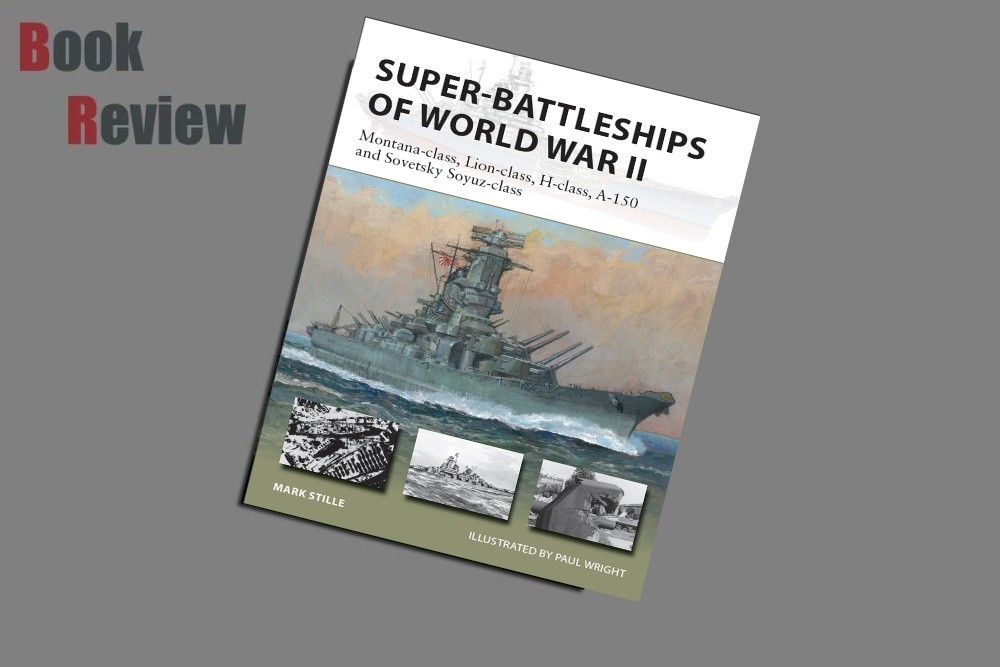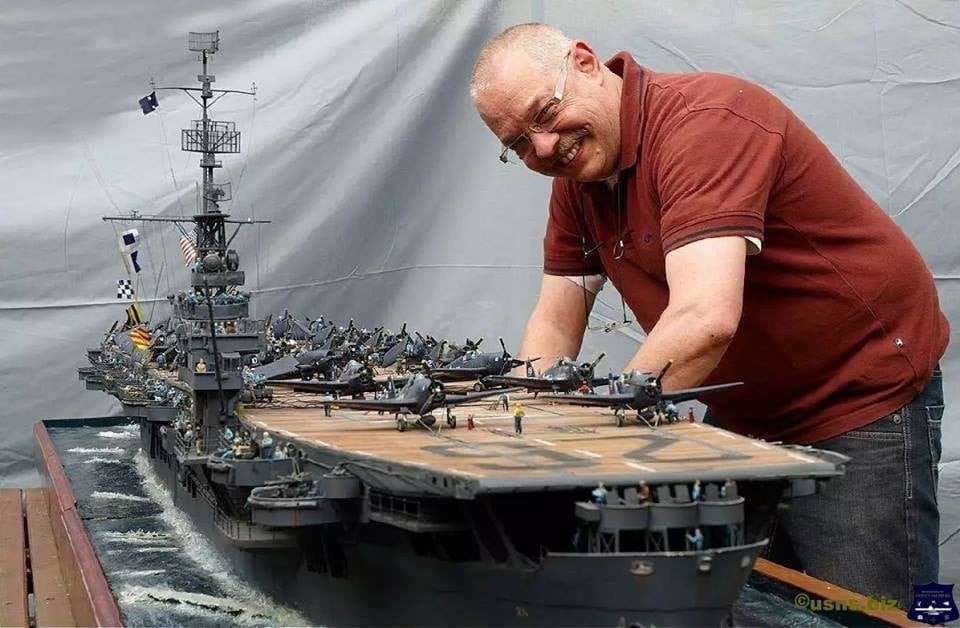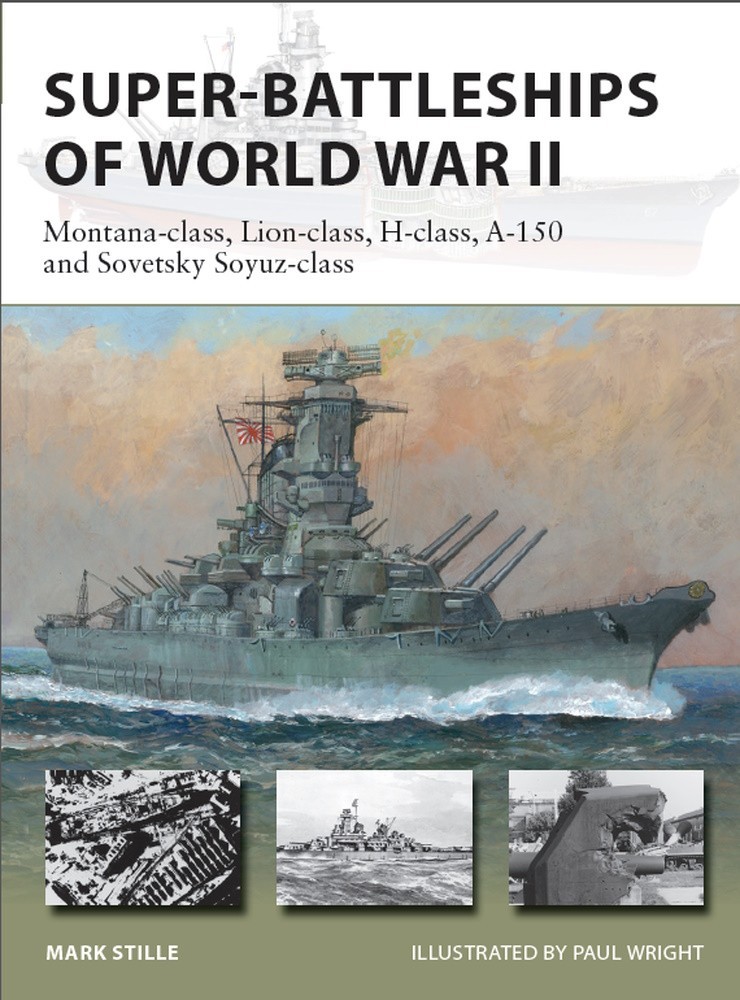
Introduction
Super-Battleships of World War II Montana-class, Lion-class, H-class, A-150 and Sovetsky Soyuz-class is a recent release from Osprey Publishing. Authored by naval historian Mark Stille and illustrated by Paul Wright, this 48-page addition to the series New Vanguard is catalogued with Osprey's short code NVG 314, and ISBN 9781472846723. It features 40 photos and 8 pages of color illustrations. It is available in paperback, PDF and ePub.
Super-anythings and "paper projects" capture the imagination of many modelers and historians. I find this book interesting in the design challenges for the engineers, often constrained under treaty limitations, and eventually by war shortages. Equally interesting is what existing technology was used compared to what new components were designed. Osprey describes this book as;
An illustrated study of the design, development and eventual fates of the uncompleted super-battleships intended to be built before and during World War II.
Before the start of World War II, the battleship was still king, and all the major powers were designing even mightier battleships to surpass their most modern and powerful classes. But when war broke out, aircraft carriers would dominate naval warfare, and none of these monster warships would ever be completed.
In this book, naval expert Mark Stille uncovers these lost battleships as they are reconstructed with the help of superb new full-colour artwork and photos. The US Navy planned five Montana-class ships, based on the Iowas but with a heavier main battery and improved protection, while the Royal Navy began work on three 16in-gun Lion-class fast battleships. The German Navy began to develop its H-class designs, initially an improved Bismarck-class which became more fantastical, culminating in the 141,500-ton, 20in-gun H-44. The Japanese A-150 was based on the Yamato-class but with 20.1in guns, while the 15 ships planned for the USSR's Sovetsky Soyuz-class would have rivalled the Montanas in size.
Explaining the design, intended roles and fate of these ships, this is the story of the last super-battleship designs in history.
Let's head to the shipyard and learn of these super what-ifs.
Between the Covers
CONTENTS
Super-Battleships of World War II is presented through 48 pages of five chapters, and front and back matter:
INTRODUCTION
BATTLESHIP DESIGN PRACTICES
• Protection
• Propulsion
• Firepower
THE SUPER-BATTLESHIP CLASSES
• The United States Navy – the Montana-class
• The Royal Navy – the Lion-class
• The Kriegsmarine – the H-class
• The Imperial Japanese Navy – Design A-150
• The Soviet Navy – the Sovetsky Soyuz-class
ANALYSIS AND CONCLUSION
FURTHER READING
INDEX
This book is organized efficiently. Call-out boxes highlight special subjects such as an explanation of the immunity zone. The author explains the histories and anticipated threats each navy issued specifications to counter. Successes and failures of designs are mentioned such as British armor being more resistant to damage than American armor and yet the King George V-class Prince of Wales was sunk by torpedoes with half the explosive force she was armored against.
Most or all of the characteristics of the following fill engineering textbooks, and Mr. Stille explains them in a concise manner, often supporting the descriptions with hard data, utilizing six pages for Introduction. Thirty-five pages are used to present the five designs explored in The Super-battleship Classes. The challenges of designing a battleship is discussed along with compromises and changing criteria, e.g., the Montana-Class design projections of displacement and size to achieve particular speeds and armament configurations varied the class from 840-1,000ft, and approximately 51,000-63,000 tons. Armor is described by type and hardness, thickness, slope, weights classification. Main battery selection considerations are discussed, as well as broadside weight for particular guns.
Each class is reviewed for the relevant requirements of:
Aircraft facilities
Armor practices and theories, i.e., all or nothing protection concept, immunity zone, face hardened armor, etc.
- Belt
- Bulkheads
- Horizontal armor
- Turret barbettes
- Main battery turrets
- Conning tower
Armament (main, secondary)
Antiaircraft protection
Fire control system
Hull numbers
Origins
Propulsion systems
Specifications:
- Displacement
- Dimensions
- Machinery
- Performance
- Range
- Crew
Performance
Finally, Analysis and Conclusion summarized these ships. Their strengths and weaknesses, and efforts to correct such, are discussed along with failures that would have handicapped the ships, i.e., German failure to develop a dual-purpose gun for ships. A full-page call-out narrates the hypothetical The Battle off Honshu, 1946, a duel between USN Montanas and a Super-Yamato.
Photographs, Artwork and Graphics
Needless to say, there are not many photos of never existing designs. The soviets did start work on a Sovetsky Soyuz-class and the book includes photos by a German reconnaissance aircraft and an USN attaché. Four photos of a Montana-class mock-up are included. Otherwise, the photos include images of ships in existence at the time, with captions explaining how the super-battleships would be different. One fascinating photo is of captured 25in.-thick armor plate of the battleship Shinano (an unfinished Yamato-class) after being hit by a USN 16in./50 gun during post-war tests. Otherwise, artwork must illustrate what our minds can imaging. Speaking of which...
Artwork
All art is accompanied with captions, usually a short narrative of the vessel, sometimes mentioning armament and equipment changes, or depicted camouflage.
USS Montana: two-page partial cutaway keyed to 26 components.
Montana in action: fictional scene of the ship in the Battle of Honshu.
Lion-Class: in profile and planform.
The H-class: in profile and planform, illustrating and describing the H-39 design of a German H-class super-battleship.
The other German super-battleship designs show the H-41 and H-42 in profile.
The last German super-battleship designs show the H-43 and H-44 in profile.
Design A-150 shows speculative views of a Design A-150 super-battleship in profile and planform.
A Japanese A-150 Super-Battleship Design in Action: in-action artwork.
The Sovetsky Soyuz-class in profile and planform.
Graphics
Several tables graphically present technical information concisely. Much of the information regarding fittings and redesigns is speculative. Each similar table (armor, performance, etc.) includes essentially the same data for each class listed, so I will not spell each out.
Super-battleship main guns list the System (gun size), Shell size, Muzzle velocity, Maximum range, and class fitted on, for these weapons:
- 16in./50
- 16in./45 Mark II
- 16in./50
- 16in./50 B-37
- 20.1in./45
Planned Montana-class construction: by name; hull number; building shipyard.
Montana-class specifications (as designed): Displacement (standard and full load); Dimensions; Machinery; Performance; Range; Crew.
Lion-class armor
Lion-class specifications (as modified in 1942)
Call-out box The last German battleship designs provides more than half a page of Hitler's massive (up to 139,000 tons) fantasy H-42, H-43 and H-44 battleships. It contains the table Characteristics of the German theoretical battleship designs listing:
- Displacement (full load in tons)
- Length
- Beam
- Main belt
- Horizontal protection
- Depth of side protection system
- Main battery guns
- Maximum speed (overload)
- Range
Planned H-39-class construction, battleship "H"-"N", date laid down, and shipyard.
Possible Design A-150 armor (mostly based on that fitted on the Yamato-class)
Planned A-150-class construction
A-150-class specifications
Call-out box Foreign assistance to the Soviet battleship program
Sovetsky Soyuz-class armor
Planned Sovetsky Soyuz-class construction
Sovetsky Soyuz-class specifications (1939 design)
Good artwork affords the modeler visual references to allow one's imagination to run wild.
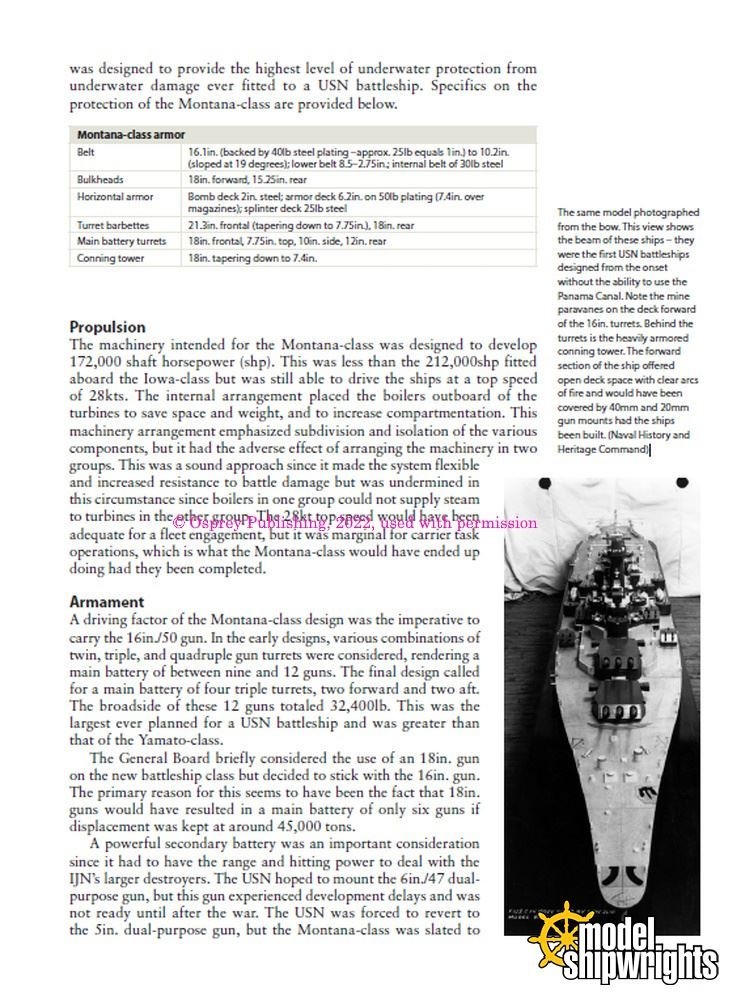
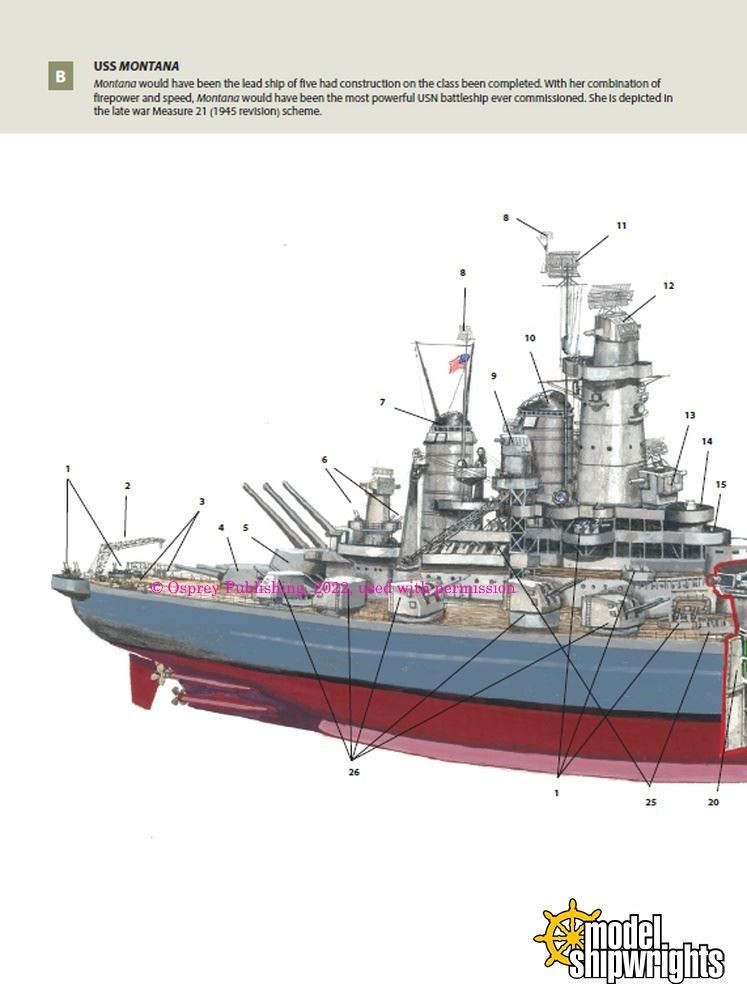
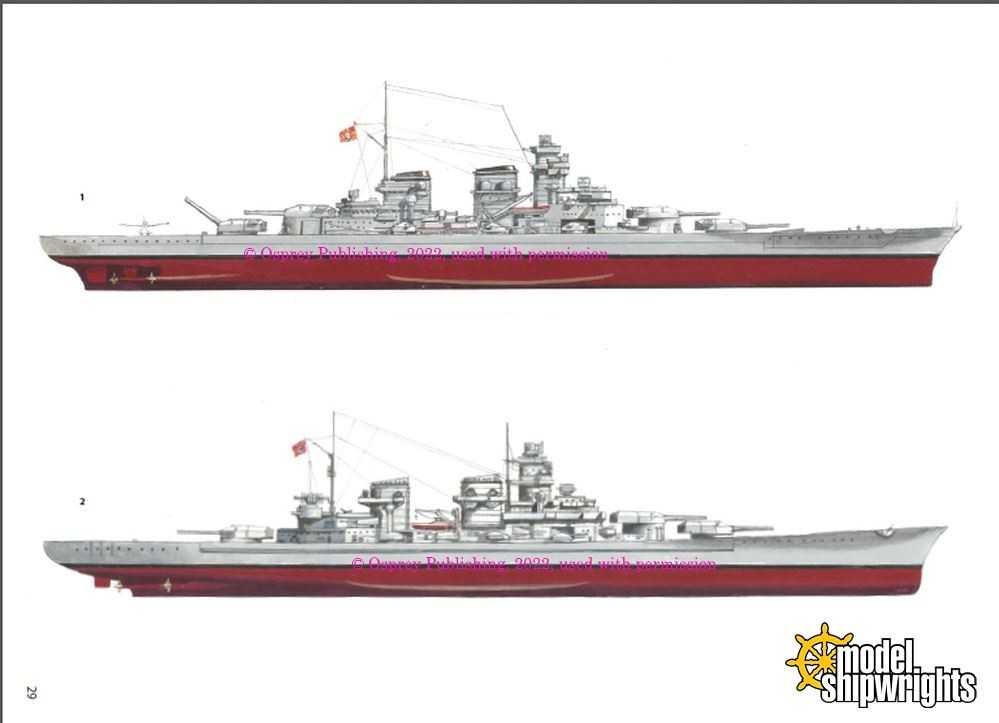
Conclusion
I find Super-Battleships of World War II from Osprey to be an interesting and intriguing account of the ultimate in battleship development of World War Two. I would like to know if the French and Italians had plans to build such behemoths. Maybe there is a part two in the works? "What-if" designs, whether "paper projects" or actual projects that never matured for whatever reason, have great appeal to many modelers. I find the development and rational for certain designs interesting. I think you will, too, and recommend this book.
Please remember to mention to Osprey and retailers that you saw this book here - on Model Shipwrights.










